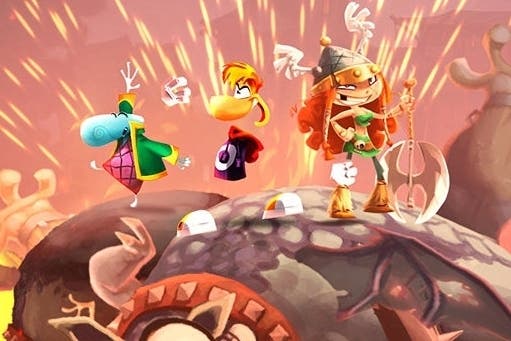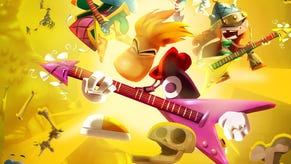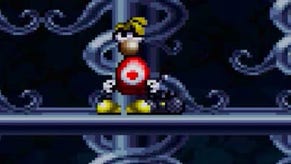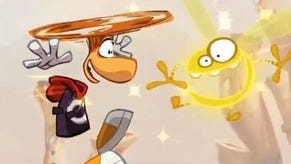Face-Off: Rayman Legends
Is the Wii U version the original and definitive?
| Xbox 360 | PlayStation 3 | PC | |
|---|---|---|---|
| Disc Size | 6.5GB | 6.82GB | 5.76GB (download) |
| Install | 6.5GB | - | 5.76GB (mandatory) |
| Surround Support | Stereo | Stereo | Stereo |
Originally built exclusively around the Wii U hardware, Rayman Legends was delayed in order to accommodate a rollout on multiple platforms - a decision that robbed Nintendo of its most promising third-party exclusive and left us genuinely worried about the game's prospects. In our initial Wii U demo analysis, we found that Ubisoft's GamePad utilisation created genuinely innovative gameplay mechanics that simply wouldn't work on any other console in the same way. With touchscreen and gyroscope features playing a big part in the level design, the inevitable consequence would surely be a game with a cut-down feature-set and a significant departure from the developer's original vision.
Thankfully, with the finished game in our hands in no less than four different formats, the good news is that our doubts have been laid to rest: Michel Ancel and the team at Ubisoft Montpellier have created one of the most beautiful, imaginative and entertaining platform games we've had the pleasure to play. While the experience is certainly different in many places on Wii U compared to other consoles, the game and its varied mechanics work very well across multiple platforms without many of the imaginative gameplay ideas being disrupted too heavily. The extra development time has also seen the inclusion of additional multiplayer modes and fully 3D boss battles that make a huge impact on sections of the game.
From a visual perspective, Rayman Legends delivers a stunning 1080p presentation across all platforms (see our quad-format comparison gallery) running at a slick 60 frames per second, with lovingly drawn 2D sprite work and well-animated polygonal characters that are entertaining to watch and full of life. It's a clear evolution - and upgrade - over the already beautiful artwork seen in Rayman Origins. Anti-aliasing is nowhere to be found in any version of Rayman Legends, though this has very little impact on how polished the game looks. Sprite edges appear smooth even when scaled, plus the pixel density that the 1080p resolution provides, in combination with the use of depth-of-field and the stylised artwork, also ensures that 3D models are for the most kept similarly jaggie-free in regular viewing distances.
What's impressive here is just how well the 2D and 3D elements work together, creating layered depth and detail in the environments while also allowing for gameplay to move seamlessly between planes. The player is thrust into the background frequently in Rayman Legends, with the camera zooming past the colourful scenery in the process. Within the first few hours we see dragons fly past in the sky, mist and smoke effects floating through the air, and buildings collapsing in an explosion of fire and rubble. The sprite-based elements and 3D models are integrated so well that at times it's hard to tell them apart, beyond the more obvious elements that freely move between planes, such as the boss characters or some of the traps that rotate and swing throughout sections of the game.
"Rayman Legends operates at native 1080p on all console platforms - giving us the opportunity to test out our next-gen full HD Face-Off workflow with a real game for the first time."
Alternative comparisons:
- Rayman Legends - Wii U vs. PC
- Rayman Legends - PlayStation 3 vs. Wii U
- Rayman Legends - Xbox 360 vs. PlayStation 3
The attention to detail is also beautiful, from the intricately drawn sprite planes to the layers of 2D effects. Backgrounds feature multiple layers of parallax containing foliage, mountains, castles and various atmospheric effects, such as mist floating through the trees in an eerie forest landscape. This is joined by a lighting model that illuminates Rayman and other characters as they move out of the shadows into the brighter parts of the scenery. Dynamic lightmaps placed across the environment appear to account for this, with characters clearly reacting to multiple light sources. We also see god-rays beaming down from the sky and light sources that appears to travel across the multiple planes illuminating objects within their path.
There are some neat artistic touches too: the alien tripods that walk in the background in some stages clearly reference War of the Worlds, while elsewhere vintage film influences are found in the names of the levels themselves (20,000 Lums Under the Sea, How To Shoot Your Dragon, etc), and in how enemies themselves behave - for example with the parachuting toads in the second world yelling out the main chorus of classical war overtures in an amusing battle cry. The combination of audio-visual elements helps to create a distinct tone and atmosphere for each area of the game, from gentle music playing in tranquil forest environments to full-on orchestral fury as players race to avoid environments collapsing around them.
All of these nuances are replicated expertly across all platforms. So from a visual perspective the only difference of note is the gamma set-up between platforms and the Wii U's limited-range RGB output. The 360 version features an image richer in contrast, where dark shadow details are slightly crushed due to the system's trademark higher gamma curve. Meanwhile, the Wii U game can look washed out on TVs that don't correctly support limited-range RGB over HDMI. It's also worth pointing out that on the PC there are no additional graphical enhancements, with the ability to adjust resolution and to run the game in windowed mode being the only options available.
In other areas, loading times between entering levels and accessing the hub world are similarly short across the 360, Wii U and PC, though we find the PS3 lagging behind by a few seconds. Unlike the 360 and PC versions, there's no option to install the game to the hard drive on the Sony platform, with data streamed directly from the Blu-ray disc. Meanwhile, the Wii U version - again bereft of an install function - is mostly likely able to keep up with the PC and 360 due to larger available pool of RAM on Nintendo's system.
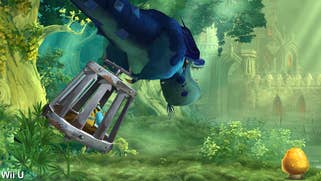
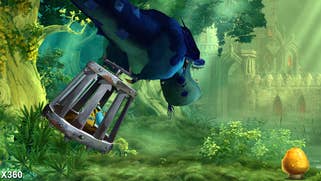

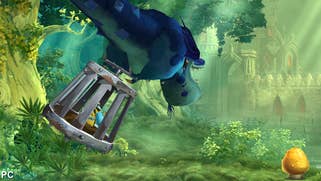
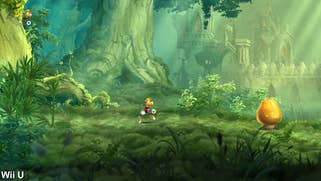
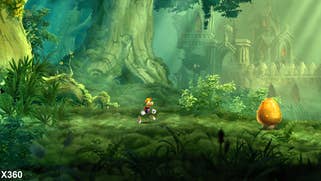
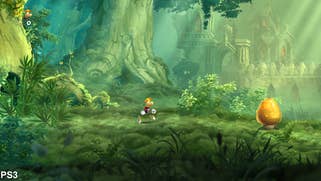
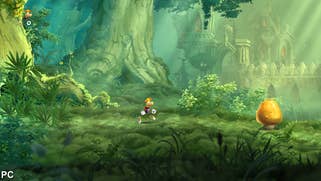
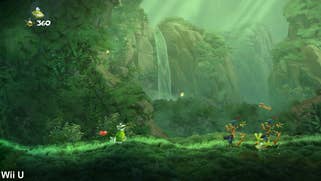
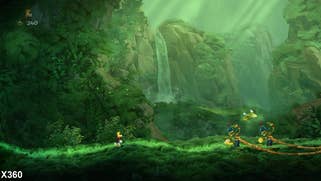
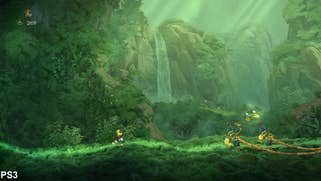
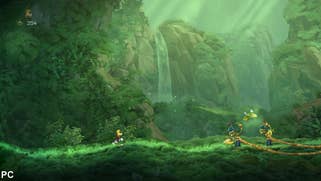
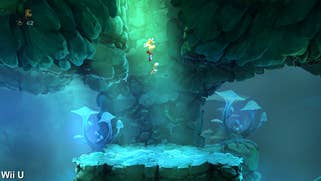
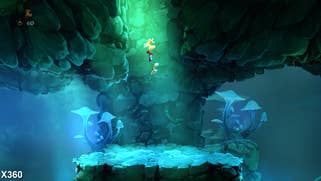
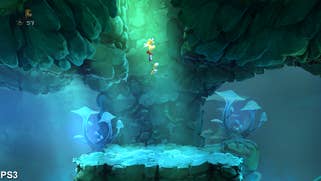
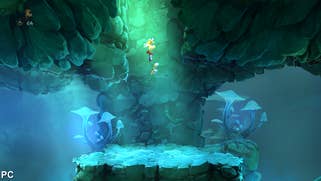

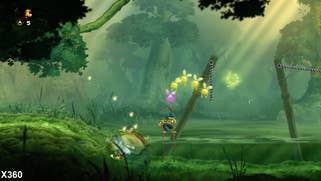
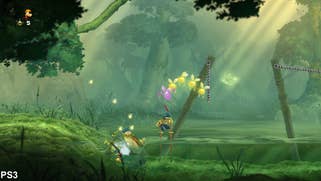
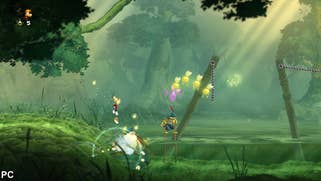
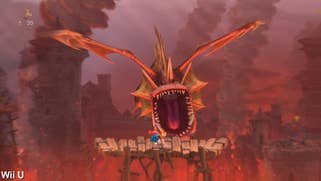
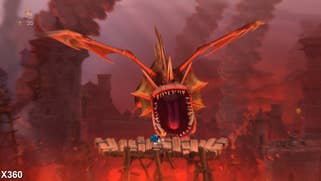


Rayman Legends on Wii U: the original, definitive experience?
Where we find more dramatic changes is in the translation from Wii U to other platforms. Rayman Legends was originally designed specifically for the Nintendo's console - with integral gameplay elements crafted around the use of GamePad's unique features - before the decision to strip the Nintendo console of its most promising third-party exclusive. The result is that many of the Wii U-specific elements have been adapted or completely changed for the other consoles in order to work using a traditional controller. Level layouts remain identical, but the way in which the player completes these challenges is very different.
For example, at various points in the Wii U game, Rayman is temporarily replaced with supporting characters Globox and Murphy. Here the player directly controls Murphy, using the GamePad's touchscreen and gyroscope to manipulate the environments and trigger certain moves to get through the level, while the CPU guides Globox along. Ropes are cut and objects moved around to clear a safe path through lava-infested pits and various other nefarious traps, while enemies are tickled using the touchscreen before being taken out with a good slap from Murphy. In other areas, the gyroscope is used to rotate parts of the level around, allowing Murphy to grab into hooks and reach platforms surrounded by spikes and other traps. In these sections, the GamePad emphasis adds in interesting puzzles and unique gameplay elements that break up the regular platforming elsewhere.
In comparison, on the other versions of the game, the player controls Rayman while using button presses on the controller to trigger Murphy at designated points. Unlike the Wii U version, the player is given far less freedom in terms of how Murphy interacts with the environment. The result is that these sections feel faster on the 360, PS3 and PC versions, with the game focusing on more of a 'perfect path' philosophy in these stages, quite similar to that of Donkey Kong Country or Sonic The Hedgehog 2.
At times this actually makes the game more enjoyable to play as the familiar platforming rhythm is disrupted less often. However, the changes don't always work quite so well, and there are points where the revisions make gameplay more fussy and less satisfying than it is on Wii U. For example, the 'What the Duck' stage sees Rayman transformed into the aforementioned bird, complete with amusing quack and playful waddle. On the Wii U the aim is to guide the CPU-controlled character through the stage by cutting pathways through layers of cake using the touchscreen. The use of the GamePad here is both intuitive and fun, with the player able to draw pathways through the level freestyle, creating slightly different routes each time you play. On the other versions, Murphy's paths are automated by the CPU, thus limiting the player's options, and at times leading to a few frustrating moments when some more obvious solutions simply cannot be used.
"Multiplayer, touchscreen and motion gameplay remains entirely exclusive to Wii U, but the compromises on other platforms have been well thought out and may appeal more to traditional platformer fans."
There are also differences between platforms in terms of multiplayer, too. During the main story mode both players share the TV screen in all versions, with the camera shunting along characters that fall behind. On the Wii U, in sections designed around the GamePad, player one adopts control of Murphy via the touchscreen, while the second person controls Globox directly. This set-up allows for one player to handle all of the platforming action while the other helps out by interacting with parts of the environment. Meanwhile, on the other consoles this unique component is lost: the gameplay is the same as in single-player mode except that there are now two players on-screen at once. Here, the CPU automates Murphy, although both players can use button presses to have him interact with enemies and the environment. The co-op elements are downscaled in comparison to the Wii U version, and thus you don't get the same level of satisfaction in working together to clear these stages.
However, despite these issues, a lot of the Wii U-specific elements have been adapted nicely into use on the standard controller, and remarkably the core level designs remain intact and just as wonderfully inventive - especially during the single-player game. There's no shortage of imagination in Rayman Legends, and the game continually throws up a number of different mechanics while dashing through a single level. One minute you might be playfully floating through a thorny forest of vines, while the next you might be thrown into a high-speed chase to rescue a captive friend being held by a wizard bent on torturing them by squeezing their nose - it's entertaining, off-the-wall stuff that is full of personality and perfectly executed, delivering challenging but fair gameplay.
Rayman Legends' captivating action is also backed up with a practically uninterrupted 60fps frame-rate across all platforms, with no signs of any screen-tear or noticeable slowdown. Bar one tiny dip in smoothness that is barely noticeable at the end of one stage, the game remains locked at 60fps throughout while blending together multi-layered sprite work and stylised 3D visuals with a range of atmospheric effects at a super-crisp native 1080p resolution.
Interestingly, there are some elements of the game that actually run at 30fps or below, but this is restricted to the 2D parts of Rayman Legends, where certain individual animations are carefully drawn by hand. This is actually a common practice where animation is concerned: the sprites themselves still scroll across the screen at 60fps (so move smoothly) but due to the amount of work involved in crafting every frame by hand, animations are executed at lower frame-rates. There are also some memory savings gains to be had here too, as heavily animated high resolution sprites can take up a hefty chunk of RAM.
"A locked 60 frames per second is the key reason that Rayman Legends looks so good and feels sublime to control - in combination with the 1080p resolution, there's no difference here between any of the console formats."
Rayman Legends: the Digital Foundry verdict
Rayman Legends is something very special indeed. The game is filled with unique ideas and bursts with imagination, beautifully demonstrating that 2D artwork still has a part to play in modern-day triple-A gaming. The art design and execution is first-rate and the gameplay is perfectly balanced with levels providing a tough but fair challenge as you progress further into the game. But really it's how all the various visual and gameplay elements work together in harmony that creates such an enjoyable experience: the combination of hand-drawn sprites and polygonal graphics are beautifully realised, worlds are filled with various effects and plenty of neat touches, while the music and general sound design successfully immerses you in the action, setting the tone for the gameplay perfectly.
The experience is basically identical across all platforms where the audio-visuals are concerned, with no single platform featuring an advantage in this regard. Although we'd have preferred to see the 360's gamma kink worked out, it's certainly not an issue either. Instead, it's with regards to the core gameplay where we see one platform break away from the rest. Built explicitly around the Wii U and the console's GamePad, this version of the game is the definitive release in terms of realising the developer's original vision for the title. The touchscreen, motion, and multiplayer elements are designed to work together in a way that simply isn't possible on any other platform - bar perhaps on the Vita (review code wasn't supplied here) - and this leads to more variety and interesting twists where the gameplay is concerned. Indeed, it will be interesting to see how the Wii U-specific elements translate to Sony's handheld, along with the superb mix of 2D and 3D artwork - the excellent Rayman Origins port bodes well for a great game on Sony's handheld and we hope to update you soon.
Overall, it's clear that the Wii U offers up the definitive version of the game as imagined by its creators, and does so by introducing GamePad-exclusive mechanics that are well thought out and that never feel like cheap gimmicks. But at the same time Rayman Legends is an outstanding release on all platforms, and an essential purchase regardless of which format you happen to own. The modified Wii U gameplay mechanics mostly come off as a complete success on the 360, PS3 and PC, and the increased focus on more traditional Rayman gameplay in these sections makes for an equally compelling alternative, if not the preferred choice for the more traditionalist gamer not that keen on touchscreen or motion-based gameplay features.
